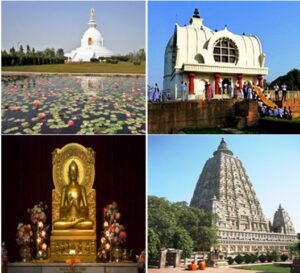
- At Sravanabelgola, 62 miles from Mysore, on a hill 470 feet above the plains and reached by nearly five hundred steps, stands the colossal statue of Bahubali, 57 feet high, 26 feet wide at the shoulders, cut from solid rock around the year 980 CE., with a surrounding vihara added in 1116. It is the biggest free-standing monolithic statue in the world. Bahubali, or Gommata, was the son of Rishabha, the first Tirthankara. This is the largest statue of Bahubali and is a major center of pilgrimage for Jains. In a Jain temple the consecrated image is ritually bathed every day as part of the worship paid to it.

The statue at Saravana Belgola is so huge that the ritual bath is carried out only on the feet of the image. At intervals of between twelve and fifteen years, a great structure of scaffolding is erected and the image is ceremonially showered from pots of water mixed with sandalwood, coconut and sugar. In 1981 the consecration ceremony marked the thousandth anniversary of the consecration of the statue.
2. The magnificent white marble Dilwaratemples on Mount Abu in Rajasthan are masterpieces of Jain architecture, unrivaled for the beauty of their carving which is so delicate that it is almost translucent. There are two major temple complexes. One was built around 1030 CE by Vimala Shah, a wealthy merchant, and dedicated to the first Tirthankara: it was restored in 1322. The forty-eight pillars of the main hall are unequaled for their decoration; the dome of eleven rings are alternately decorated with human and animal figures. The later temple, dedicated to Neminatha, is larger, 155 feet long, and was founded around 1230 by Tejapala and his brother Vastupala, prime minister to the regent of Gujarat, who built more than fifty religious edifices, including foundations at Satrunjaya and Girnar. The panoramic view from 4000 feet above sea level make this site a place of deep religious significance.
- Girnarin Junagarh district and Satrunjayain Bhavnagar district in Gujarat are so rich in temples and shrines that they have been described as temple cities.
Girnar is celebrated as the place where the Tirthankara Neminatha achieved moksha. The temple is in a rectangular courtyard surrounded by some seventy Tirthankara images. This is the largest temple but there are many others, including one founded by Vastupala in 1231 A.D. and dedicated to the nineteenth Tirthankara Mallinatha.
Satrunjaya is an ancient Jain pilgrimage site, where the first Tirthankara Rishabha reached moksha. Many hundreds of temples and smaller shrines are contained within the nine walled enclosures. Although most of them date to the nineteenth century, traditional accounts speak of sixteen restorations going back into antiquity. A new temple of Rishabha replaced the old one in the mid-twelfth century and seven shrines were placed in front of it in 1231 by Vastupala.
4. Ranakpurin Pali district, Rajasthan is a magnificent temple complex, dating to the fifteenth century. It covers 40,000 square feet. The main sanctuary has four six-foot white marble statues of Rsabha, the first Tirthankara, facing the four directions. Innumerable pillars, said to be 1444, richly carved and all different, hold up the twenty-nine halls, interspersed by open courts.
5. In 1300 CE the Jain king of Gujarat, Kumarapala, founded a temple at Tarangain Mehsana district, Gujarat. The temple was destroyed but was renovated much later during the reign of the Moghul emperor Akbar in the sixteenth century. It is picturesquely situated on the top of a hill with a difficult approach testing the endurance of pilgrims.
BUDDHIST YATRAS

There are four major sites of Buddhist pilgrimage:
- The Buddha’s birthplace at Lumbini, Nepal, the site where he was born.
- The pipal tree at Bodh Gaya, near Benares, Uttar Pradesh, where he achieved enlightenment.
- The deer park at Sarnath, outside Varanasi, Uttar Pradesh, where the Buddha delivered his first sermon.
- Kushinagara, in Uttar Pradesh, where the Buddha attained parinibbana (liberation).
Source: http://gnai.nl/zuid-azie/kerala/


